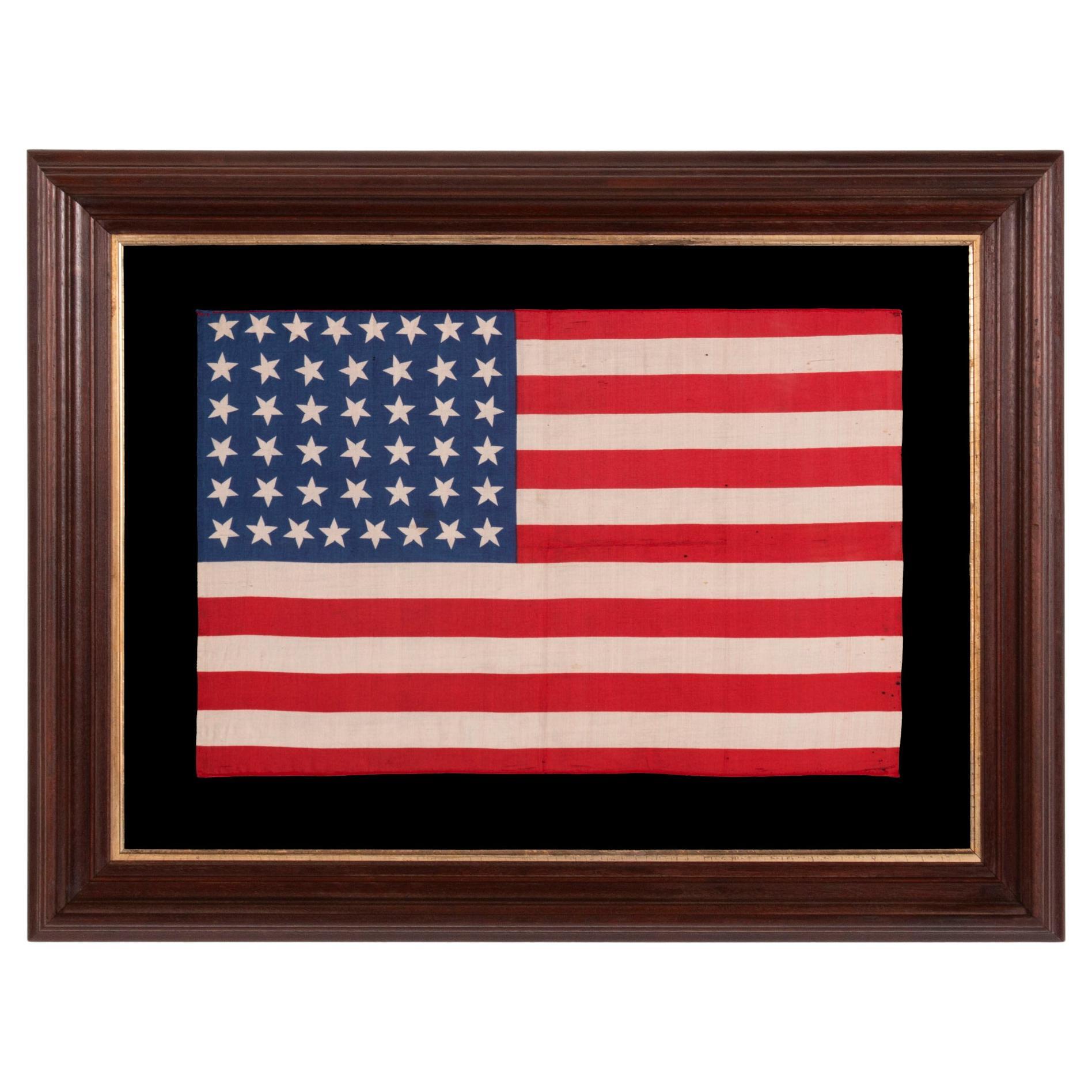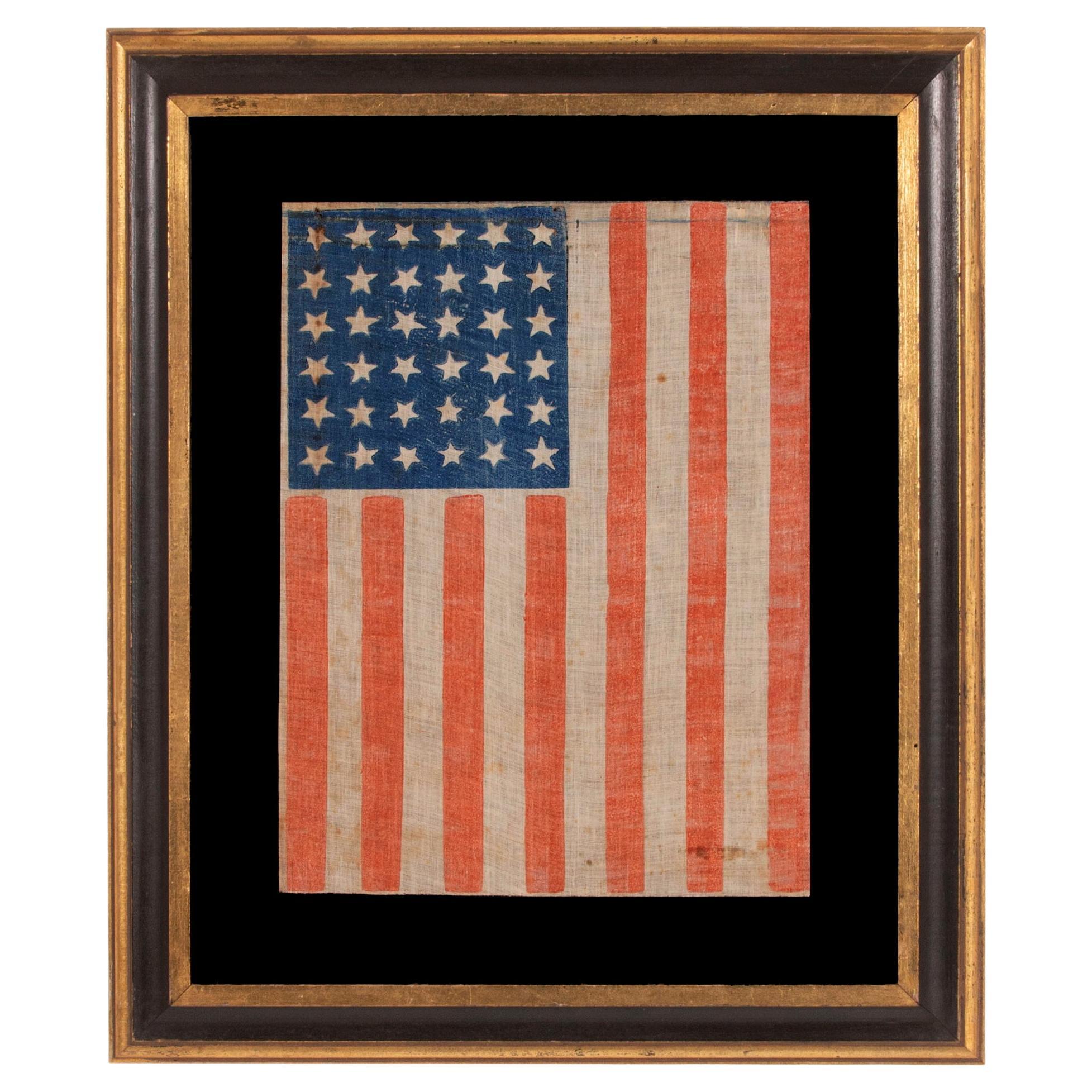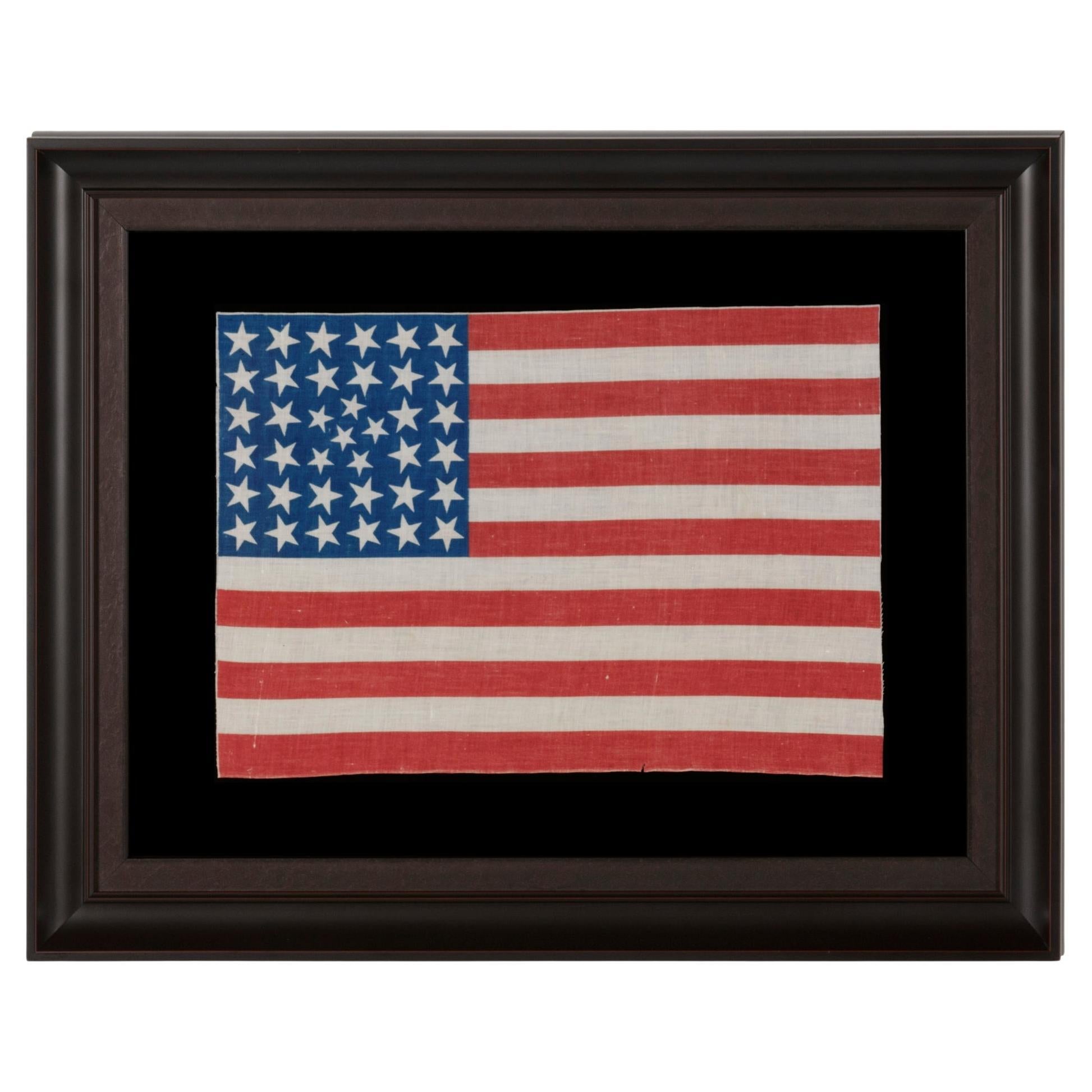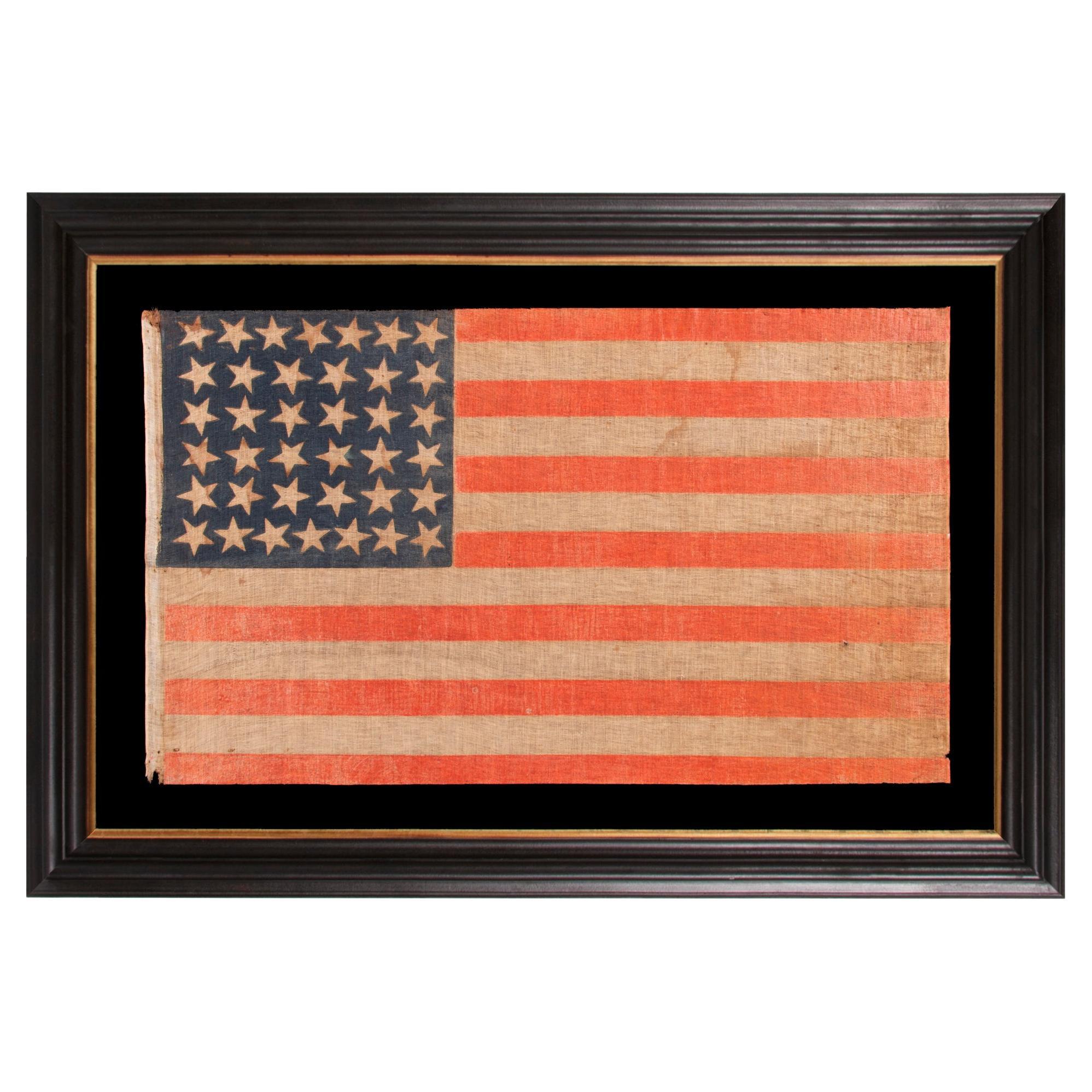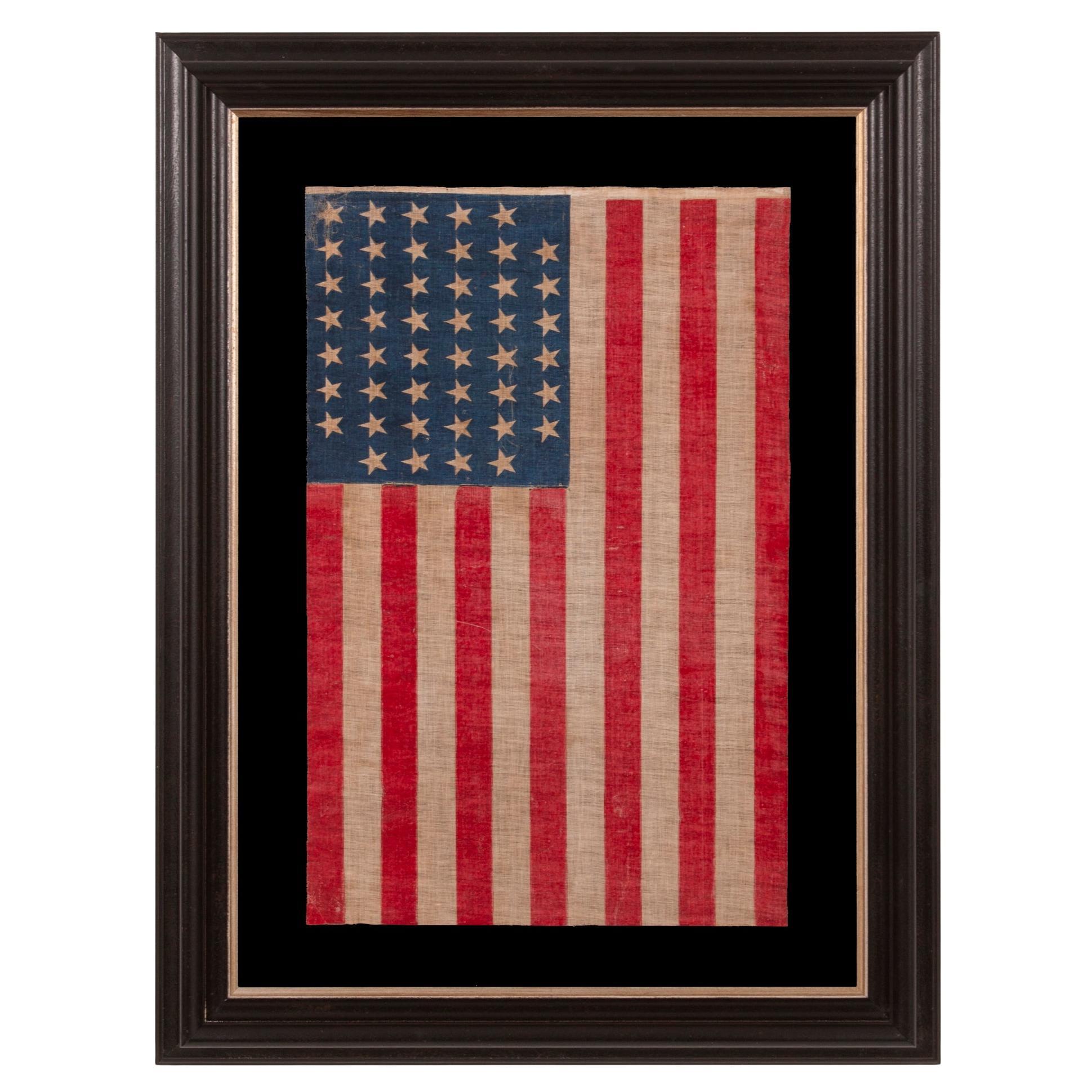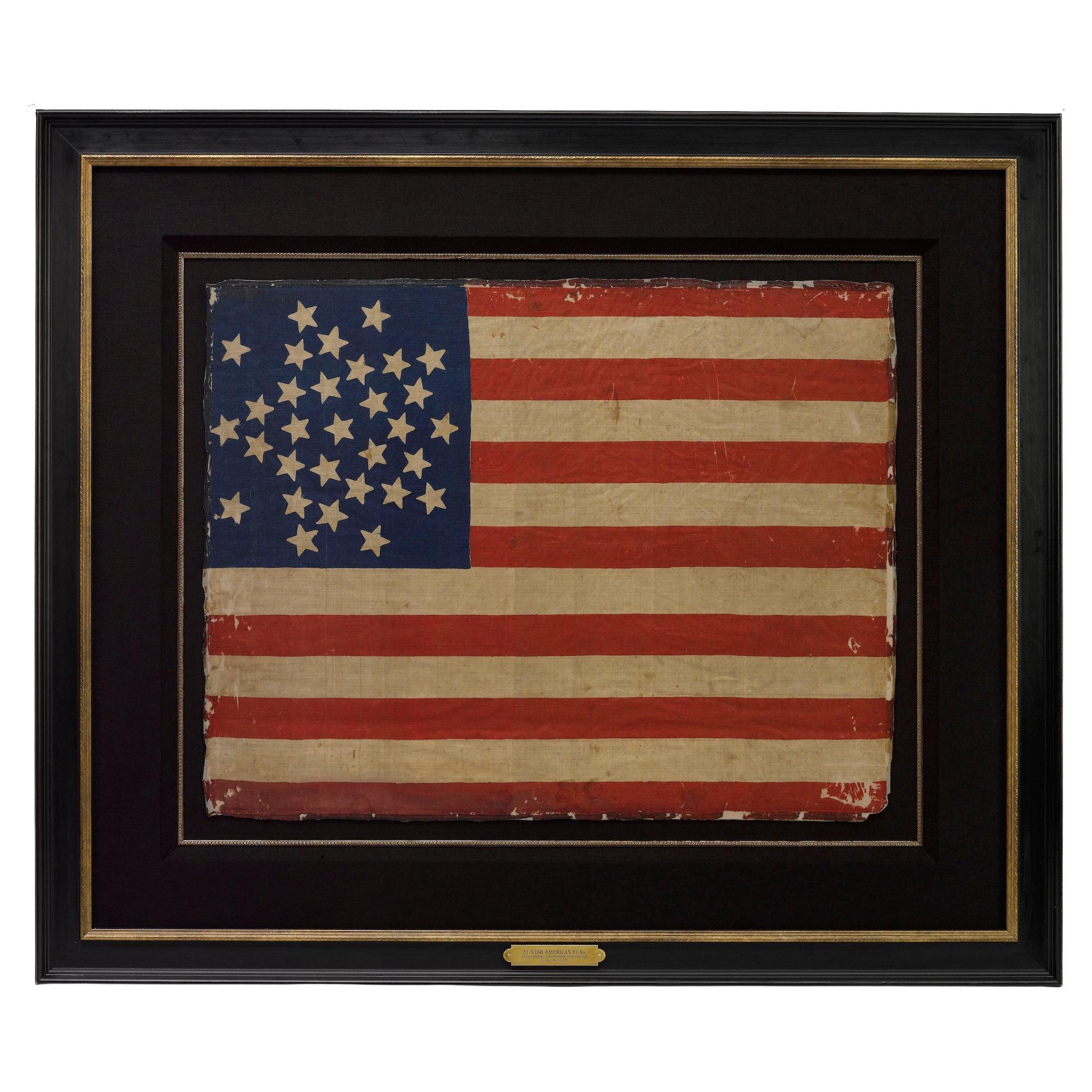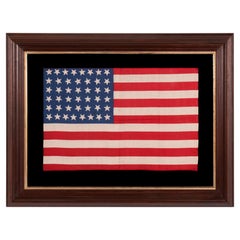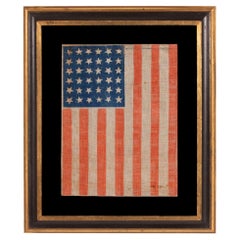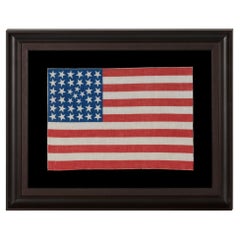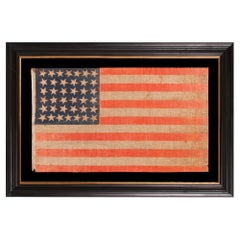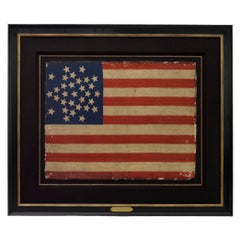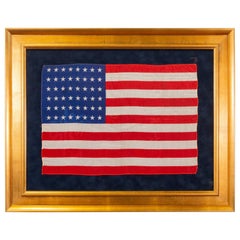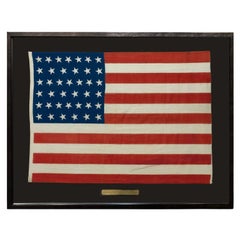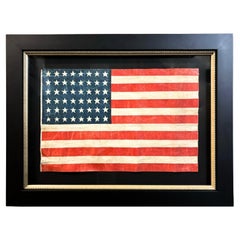Items Similar to Early Silk Kerchief Displaying the California State Bear Flag, ca 1915
Want more images or videos?
Request additional images or videos from the seller
1 of 6
Early Silk Kerchief Displaying the California State Bear Flag, ca 1915
$1
£0.75
€0.87
CA$1.39
A$1.55
CHF 0.81
MX$19.02
NOK 10.27
SEK 9.70
DKK 6.49
Shipping
Retrieving quote...The 1stDibs Promise:
Authenticity Guarantee,
Money-Back Guarantee,
24-Hour Cancellation
About the Item
EARLY KERCHIEF IN THE FORM OF THE CALIFORNIA STATE BEAR FLAG, PROBABLY MADE FOR THE PANAMA-PACIFIC INTERNATIONAL EXPOSITION IN SAN FRANCISCO IN 1915
Printed on silk, this beautiful kerchief is styled in the format of the California State flag. Extremely rare, this is an unusual object and I am unaware of any other state flags that were produced in this manner. The most likely date is somewhere between roughly 1911 and 1920, though it could date slightly thereafter. The construction of this particular style of kerchief, with a border that is separated from the body by a fine line that is absent of horizontal threads, first appears in political campaign material in the 1888 election year. Various examples have been identified between that date and 1913, when a version was produced to celebrate the inauguration of Woodrow Wilson. None seem to have been made for the 1916 election, though other types appear with patriotic images during WWI (U.S. involvement 1917-18).
Early state flags fall between very scarce and extraordinarily rare in the antiques marketplace. One primary reason for this is that most states, even if they existed during the 18th or 19th century, didn’t actually adopt flags until the early 20th century. The Maryland State Legislature, for example, didn’t find need for a state banner until 1904, in spite of the fact that Maryland was one of the original 13 colonies. Other states had crests or symbols that were tied to the state legislature in some way, or to local patriotism, but didn't accept an official design until many years following statehood.
In the case of California, the "Bear Flag," as all California state flags and variations thereof are often called, is based on a significant early example. The eldest surviving Bear Flag is thought to date to the 1846 “Bear Flag Revolt”. This occurred when Major John Frémont arrived in the state on a so-called mission to reach the Pacific and encouraged an uprising against Mexican rule in the territory. Frémont claimed himself military governor of the California Republic and was brought up on charges of treason for his actions, but was pardoned by President James Polk. Polk was an expansionist and Frémont’s actions brought California to statehood in 1850, immediately following the 1849 Gold Rush.
The original Bear Flag was designed and made by William L. Todd, a first cousin to Abraham Lincoln’s wife, Mary Todd. Painted on cotton, it had a white field with a red stripe along the bottom, just like the modern design. The star image was taken from what was known as the “California Lone Star Flag”, flown during California's previous, 1836 revolt. Like the modern California flag, the red star appeared the upper hoist-end corner, but the bear was placed next to the star. On a later version, designed by a man named Peter Storm in 1870, the bear was fierce and walking. On the modern design it is black and brown, centered on the field, prominently huge, and walking.
The bear on the first bear flag and other early bear flags more closely resembles the more common American black bear than a grizzly, seen in the lack of shoulder hump and narrower muzzle. The bear on Storm’s 1870 version closely resembles the coat of arms of Bern, Switzerland, its capital city. The coat of arms displays a black bear walking toward the left with fierce claws and a protruding tongue. It is of interest to note that Switzerland was the home country of John Sutter, who established Sutter's Fort, in the area which would spawn the California Gold Rush and eventually become Sacramento, California's state capital.
On Todd’s 1846 flag, the words “California Republic” were likewise in black, but the letters spanned the width of the star and bear images and were placed immediately below them. Today they are underneath the large bear, just above the red bar. Unfortunately, Todd’s flag was destroyed in the fires following the 1906 San Francisco earthquake, but an image of it survives in a photograph, taken in 1890.
The bear flag did not become the official California state flag, however, until it was adopted by the California State Legislature and signed into law by Governor Hiram Johnson in 1911. States were regularly participating in World’s Fair events by this time—popular between the late 19th and mid-20th centuries—and were probably compelled to create state banners because other states had them, so it would have seemed improper not to obtain one and follow suit.
While the kerchief may conceivably have been made to honor the adoption of the new flag, the most likely reason for the production would be for sale at the Panama–Pacific International Exposition in San Francisco in 1915. Other kerchiefs made for the Expo, in different designs, are known to exist with the same construction. While use at the California Liberty Fair in Los Angeles in 1918 is a possibility, that event was far-and-away smaller in scale and occurred during a influenza epidemic that began in 1918 and ravaged the city.
Brief Description of the Panama-Pacific International Exhibition:
“The vast fair, which covered over 600 acres and stretched along two and a half miles of water front property, highlighted San Francisco’s grandeur and celebrated a great American achievement: the successful completion of the Panama Canal. Nine years earlier, San Francisco experienced a terrible earthquake, declared one of America’s worst national disasters. The city overcame great challenges to rebuild and by the time the Exposition opened in 1915, the city was ready to welcome the world.
Between February and December 1915, over 18 million people visited the fair; strolling down wide boulevards, attending scientific and educational presentations, “travelling” to international pavilions and enjoying thrilling displays of sports, racing, music and art. The fair promoted technological and motor advancements: the Panama-Pacific International Exposition was the first world’s fair to demonstrate a transcontinental telephone call, to promote wireless telegraphy and to endorse the use of the automobile. Each day, the fair highlighted special events and exhibits, each with their own popular souvenirs. The fair was so large and spread out over such a length of land that it was virtually impossible for any visitors to successfully see it all, even over the course of several visits.” (Source: National Park Service).
Mounting: For 25 years we have maintained a specialized department for this purpose. Our lead conservator holds a master's degree in textile conservation from one of the nation’s top university programs. We take great care in the mounting and preservation of flags and related textiles and have preserved thousands of examples.
The background is 100% cotton twill, black in color. The two-part molding consists of a deep shadowbox style frame with a stepdown profile and a finish that is very dark brown in color, nearly black, with reddish undertones and highlights, to which a flat profile molding with a finish like old gunmetal was added as a liner. The glazing is U.V. protective acrylic (Plexiglas).
Condition: There are areas of minor to very modest soling and water staining throughout, accompanied by modest to moderate soiling in the upper right-hand quadrant, most notable along and adjacent to the border, and near the center, just above the red bar.
- Dimensions:Height: 25.5 in (64.77 cm)Width: 24.75 in (62.87 cm)Depth: 2 in (5.08 cm)
- Materials and Techniques:
- Place of Origin:
- Period:
- Date of Manufacture:1915
- Condition:See Item Description.
- Seller Location:York County, PA
- Reference Number:Seller: ker-2601stDibs: LU849745924042
About the Seller
5.0
Recognized Seller
These prestigious sellers are industry leaders and represent the highest echelon for item quality and design.
Established in 1991
1stDibs seller since 2008
70 sales on 1stDibs
Typical response time: 1 to 2 days
- ShippingRetrieving quote...Shipping from: York County, PA
- Return Policy
Authenticity Guarantee
In the unlikely event there’s an issue with an item’s authenticity, contact us within 1 year for a full refund. DetailsMoney-Back Guarantee
If your item is not as described, is damaged in transit, or does not arrive, contact us within 7 days for a full refund. Details24-Hour Cancellation
You have a 24-hour grace period in which to reconsider your purchase, with no questions asked.Vetted Professional Sellers
Our world-class sellers must adhere to strict standards for service and quality, maintaining the integrity of our listings.Price-Match Guarantee
If you find that a seller listed the same item for a lower price elsewhere, we’ll match it.Trusted Global Delivery
Our best-in-class carrier network provides specialized shipping options worldwide, including custom delivery.More From This Seller
View All44 Star Silk Antique American Flag, Wyoming Statehood, ca 1890-1896
Located in York County, PA
44 STARS IN JUSTIFIED ROWS, WITH VARIED STAR POSITIONING, ON A SILK, ANTIQUE AMERICAN FLAG WITH STRIKING COLORS, REFLECTS WYOMING STATEHOOD, circa 1890-1896
44 star American parade ...
Category
Antique Late 19th Century American Political and Patriotic Memorabilia
Materials
Silk
Price Upon Request
36 Star Antique Parade Flag, Vertical Position, Nevada Statehood, ca 1861-1867
Located in York County, PA
36 STAR ANTIQUE AMERICAN PARADE FLAG, WITH STARS THAT ALTERNATE IN THEIR VERTICAL POSITION FROM COLUMN TO COLUMN AND ROW-TO-ROW, PRINTED ON AN ESPECIALLY INTERESTING LENGTH OF COARSE...
Category
Antique Late 19th Century American Political and Patriotic Memorabilia
Materials
Cotton
38 Star Antique American Parade Flag, Colorado Statehood, ca 1876-1889
Located in York County, PA
38 STARS IN AN EXTREMELY UNUSUAL CONFIGURATION THAT BEARS A CLUSTER OF 6 SMALL STARS WITHIN A LINEAL PATTERN OF LARGER STARS, 1876-1889, COLORADO STATEHOOD
38 star American national parade flag, printed on cotton. This is an extremely rare example of a lineal pattern flag with a wreath or cluster of smaller stars inserted in the center. A very small number of flags in this style are known to have survived, the colors of which are typically saturated and vibrant, like this example, in scarlet red and rich, royal blue.
The particular wreath in the center of the configuration is really more of a pentagon with a single, center star. The reason for the choice of the design and 6 smaller stars seems a curious one on the surface, but its purpose was probably nothing more than to simply augment a 36 star print block to one with 38 stars. One may observe how 4 stars, that would have comprised the center of a 6 x 6 pattern, could have simply been removed and 6 smaller stars inserted in their place, in an artful fashion.
At least two other similar 38-star patterns are known that incorporate 4 small stars intermingled between rows of what most certainly were two very similar 34-star flag print blocks originally. It was easier to modify these blocks rather than create brand new ones. In these particular instances, the results are rare, quirky configurations that are highly prized by collectors.
Colorado became the 38th state on August 1st, 1876. This was the year of our nation’s 100-year anniversary of independence. Per the Third Flag Act of 1818, stars were not officially added until the 4th of July following a state's addition. For this reason, 37 was the official star count for the American flag in 1876. Flag-making was a competitive venture, however, and few flag-makers would have been continuing to produce 37 star flags when their competitors were making 38’s. It is for this reason that 38 and 13 stars (to represent the original 13 colonies) are more often seen at the Centennial International Exposition, the six-month long World’s Fair held in Philadelphia in honor of the event. Some flag-makers would have been adding a star for the 38th state even before it entered the Union, in the early part of 1876 or even prior. In fact, many makers of parade flags were actually producing 39 star flags, in hopeful anticipation of the addition of two more Western Territories instead of one. But the 39th state would not join the Union for another 13 years, when the Dakota Territory entered as two states on the same day. The 38 star flag became official on July 4th, 1877 and was generally used until the addition of the Dakotas in 1889.
Provenance: Jeff R. Bridgman Antiques to the late collector Jim Ring...
Category
Antique Late 19th Century American Political and Patriotic Memorabilia
Materials
Cotton
Price Upon Request
38 Star Antique American Parade Flag, Colorado Statehood, ca 1876-1889
Located in York County, PA
38 STAR ANTIQUE AMERICAN PARADE FLAG WITH JUSTIFIED ROWS OF 7-6-6-6-6-7 AND SCATTERED STAR ORIENTATION, MADE DURING THE PERIOD WHEN COLORADO WAS THE MOST RECENT STATE TO JOIN THE UNION, 1876-1889
38 star American national parade flag, printed on coarse cotton, possibly with flax content. One of the flag’s most interesting features is the wild sweep of the grain of the fabric, the warp and weft of which are anything but perpendicular.
The stars are arranged in justified rows of 7-6-6-6-6-7. This results in a secondary pattern that I commonly call a “box-in-a-box-in-a-box”, because of the way in which the seemingly haphazard arrangement creates three consecutive squares. Note how the stars point in various directions on their vertical axis, which adds a nice element of folk quality to the overall design.
Most parade flags in this star count have red stripes that lean heavily toward orange, with a vibrant, chromatic luster. This was common across printed flags produced between the 1850's and the 38 star period, phasing out in the last decade of the 19th century. Also note how the wear and patina contribute to an endearing presentation that displays its long-term use gracefully.
Colorado became the 38th state on August 1st, 1876. This was the year of our nation’s 100-year anniversary of independence. Per the Third Flag Act of 1818, stars were not officially added until the 4th of July following a state's addition. For this reason, 37 was the official star count for the American flag in 1876. In the latter 19th century, it became common to add stars before the respective state(s) had even entered the Union. No one cared what was official, not even the military, where the matter of practicality with regard to flags always seems to have outweighed regulations. In the private sector, commercial flag-making was a competitive venture. Few flag-makers continued to produce 37 star flags when their competitors had jumped the star count to 38. It is for this reason that 38 and 13 stars (to represent the original 13 colonies) are more often seen at the Centennial International Exposition, the six-month long World’s Fair, held in Philadelphia, that served as the nucleus of the national celebration.
Some makers of printed parade flags actually began to produce 39 star flags in 1876, in hopeful anticipation of the addition of two more Western Territories instead of one. The 39th state would not join the Union for another 13 years, however, when the Dakota Territory—thought to be coming as a single state—entered as two separate states on November 2nd, 1889. The 38 star flag generally fell out of production at that time, though it technically remained official until July 3rd, 1890.
President Ulysses S. Grant was in office when the first 38 star flags would have appeared. The list of presidents that served during the period when the 38 star flag was official include Rutherford B. Hayes, James Garfield...
Category
Antique Late 19th Century American Political and Patriotic Memorabilia
Materials
Cotton
Price Upon Request
45 Stars Antique American Parade Flag, Utah Statehood, ca 1896-1908
Located in York County, PA
45 STAR ANTIQUE AMERICAN PARADE FLAG WITH ITS STARS ARRANGED IN A NOTCHED PATTERN, 1896-1908, UTAH STATEHOOD:
45 star American national flag, printed on coarse, glazed cotton. Evide...
Category
Antique 1890s American Political and Patriotic Memorabilia
Materials
Cotton
Price Upon Request
38 Star Parade Flag with Whimsical 6-Pointed Stars, Colorado Statehood
Located in York County, PA
38 WHIMSICAL STARS, WITH 6-POINTED PROFILES, SIMILAR TO THE STAR OF DAVID, ON AN ANTIQUE AMERICAN FLAG OF THE CENTENNIAL ERA; A REMARKABLE SPECIMEN, ONE-OF-A-KIND AMONG KNOWN EXAMPLE...
Category
Antique Late 19th Century American Political and Patriotic Memorabilia
Materials
Cotton
Price Upon Request
You May Also Like
31-Star Printed American Flag, Celebrating California Statehood, Circa 1850
Located in Colorado Springs, CO
This is a rare 31-star medallion printed American flag, celebrating the addition of California to the Union. The flag is printed on silk and has a spectacular “Great Star” canton pat...
Category
Antique 1850s American Political and Patriotic Memorabilia
Materials
Silk
Vintage 1912 Arizona and New Mexico Statehood Flag
Located in Coeur d'Alene, ID
25th Design Patriotic American silk flag with 48 stars. Arizona Statehood Feb 14, 1912; New Mexico Statehood Jan 6, 1912
Period: 1912
Origin: United States
Size: 12" x 17".
Family ...
Category
Vintage 1910s American Historical Memorabilia
Materials
Silk
39-Star Antique American Flag with 'Whimsical' Star Pattern, 1889
Located in Colorado Springs, CO
This is a 39-star unofficial American flag, handmade and printed on cotton. The flag dates to 1889 and has a unique history, thanks to its rare star-count.
The flag’s canton is prin...
Category
Antique 1880s American Political and Patriotic Memorabilia
Materials
Cotton
48-Star Printed American Flag, Commemorating Arizona Statehood, 1912-1958
Located in Colorado Springs, CO
This is an original 48-star American parade flag, celebrating Arizona statehood. A wonderful product of our nation's early history, this flag is an authentic antique, with a fly date...
Category
Mid-20th Century American Political and Patriotic Memorabilia
Materials
Fabric
19th Century American 39 Star Flag, circa 1889
Located in Nantucket, MA
19th Century American 39 Star Flag, circa 1889, a period printed silk parade flag with a wavy pattern of dancing stars. This was never an official flag of the United States but was m...
Category
Antique 1880s American Federal Political and Patriotic Memorabilia
Materials
Silk
45-Star American Flag, Printed on Cotton, Celebrating Utah Statehood, 1896-1908
Located in Colorado Springs, CO
This 45-star United States flag celebrates the statehood of Utah. 45-star flags served as the official American flag from 1896-1908. This particular flag was flown as a parade flag. ...
Category
Antique 1890s American Political and Patriotic Memorabilia
Materials
Cotton
More Ways To Browse
Buermann Spurs
Scary Antique Toys
Alice Tack
Civil War Cannon Balls
Leo Cherne
Vintage Asafo Flags
Vintage 49 Star Flag
Antique Scary Dolls
Eagle Of The French National Guard
Vintage Defiance Flag
Tar Bucket
Ron Nixon
Vintage Texas Flag
Odd Fellows Banner
Ethan Allen Framed Art Print
Mason And Hamlin
Catt Furniture
Antique Truncheon
